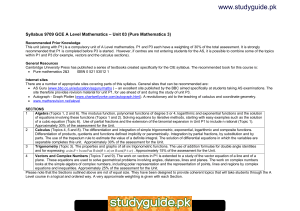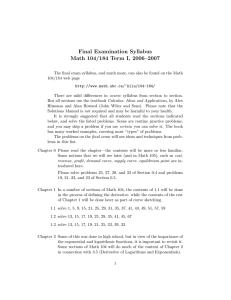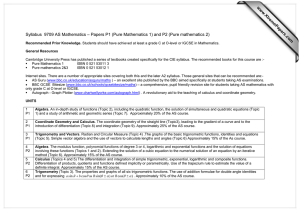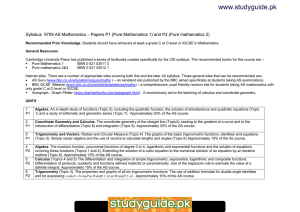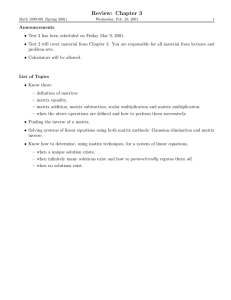1 AM SYLLABUS (2016) PURE MATHEMATICS
advertisement
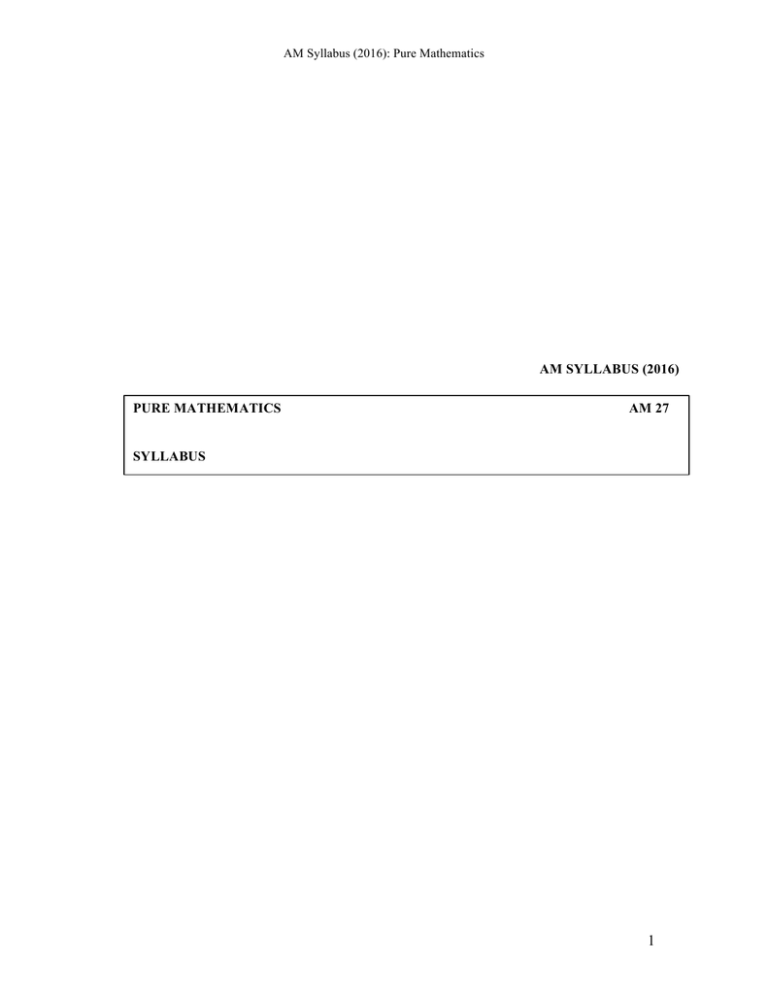
AM Syllabus (2016): Pure Mathematics AM SYLLABUS (2016) PURE MATHEMATICS AM 27 SYLLABUS 1 AM Syllabus (2016): Pure Mathematics Pure Mathematics AM 27 Syllabus 1. (Available in September ) Paper I(3hrs)+Paper II(3hrs) AIMS • • • • • • To prepare students for further studies in Mathematics and related subjects. To extend the students’ range of mathematical techniques so as to apply them in more difficult and unstructured problems. To develop in students the ability to read and understand a wider range of mathematical articles and arguments. To enable students to formulate a mathematical representation of a real life situation. To use appropriate technology such as computers and calculators as a mathematical tool. To encourage confidence, enjoyment and satisfaction through the development and use of Mathematics. The syllabus assumes a good knowledge of the subject at SEC level and coverage of the extension topics in Paper 2A. It aims at consolidating this knowledge and to extend it to include more advanced concepts. 2. ASSESSMENT OBJECTIVES Candidates are required to: • demonstrate their knowledge of mathematical facts, concepts, theories and techniques in different contexts. • construct mathematical arguments and proofs by means of precise statements, logical deduction and inference. • recognise standard models and be able to apply them. 3. SCHEME OF ASSESSMENT The examination will consist of 2 papers of 3 hours each. Any examination question can test material from more than one topic. Questions may be set on topics which are not explicitly mentioned in the syllabus but such questions will contain suitable guidance so that candidates will be able to tackle them with the mathematical knowledge they would have acquired during their studies of the material in the syllabus. Knowledge of topics in Paper 1 is assumed and may be tested in Paper 2. Graphical calculators will not be allowed however scientific calculators could be used but all necessary working must be shown. A booklet with mathematical formulae will be provided. Paper 1 will contain 10 questions, possibly of varying difficulty. Marks allotted to each question will be shown. The total number of marks available in the paper is 100 and candidates will have to answer all the questions. Paper 2 will contain 10 questions and candidates will be asked to choose 7 questions. Each question will carry 15 marks. 4. GRADE DESCRIPTION 2 AM Syllabus (2016): Pure Mathematics Grade A: • Candidates who are able to recall and select almost all concepts, techniques and theories required in different contexts. • Candidates who use diagrams and sketches with a high level of accuracy and who are able to proceed logically in their proofs. • Candidates who derive results to a high degree of accuracy. Grade C: • Candidates who are able to recall and select most concepts, techniques and theories required in different contexts. • Candidates who use diagrams and sketches with a reasonable level of accuracy and who are able to proceed logically in their proofs. • Candidates who derive results to an appropriate degree of accuracy. Grade E: • Candidates who are able to recall and select some concepts, techniques and theories required in different contexts. • Candidates who use diagrams and sketches with some accuracy and who are able to proceed logically in their proofs. • Candidates who derive results to a fair degree of accuracy. 5. SUBJECT CONTENT The topics are not arranged in teaching order. The syllabus is not meant as a teaching scheme and teachers are free to adopt any teaching sequence that they deem to be suitable for their students. Pure Mathematics Paper 1 Topics 1. Notes Surds, Indices, Logarithms, Partial Fractions and Quadratics Classification of numbers: ℝ, ℂ, ℕ, ℚ and ℤ. Use and manipulation of surds. Positive and negative rational indices To include simplification and rationalisation of the ! !!! ! denominator of a fraction e.g. 15 − 4 27; ! !!! ! Properties of Indices i.e. Zero, negative and fractional. Applying the laws of indices Powers of products and quotients 3 AM Syllabus (2016): Pure Mathematics Simplifying expressions e.g. Logarithms Partial Fractions Remainder and factor theorem ! !!! ! !!(!!!)!! !(!!!) . Definition of logarithms, the laws of logarithms. Common and natural logarithms. Change of base formula. Solution of equations involving indices and logarithms Include cases where the denominator is of the form: - (𝑎𝑥 + 𝑏)(𝑐𝑥 + 𝑑)(𝑒𝑥 + 𝑓) - (𝑎𝑥 + 𝑏) 𝑐𝑥 + 𝑑 2 - (𝑎𝑥 + 𝑏)(𝑐 𝑥2 + 𝑑𝑥 + 𝑒) Include improper fractions. In these cases the degree of the denominator must not be greater than three. Finding the remainder and also factorizing cubic or quartic expressions. Sum and difference of two cubes Pascal’s triangle Quadratic equations • • • Simple inequalities in one variable Solution of quadratic equations by factorizing or by completing the square. Locating the maximum or minimum value of a quadratic function. Sketching quadratic functions. Nature of roots of a quadratic equation. Knowledge of the relation between the roots 𝛼 and 𝛽 and the coefficients of a quadratic equation. Forming new equations with roots related to the original. Calculations of expressions up to the third degree e.g. 𝛼 ! + 𝛽 ! . Graphical or algebraic solution of: • • • • • Linear inequalities Quadratic inequalities Cubic inequalities, which can be factorized in at least one linear factor Inequalities involving modulus of functions of the above type Rational inequalities reducible to the third degree 4 AM Syllabus (2016): Pure Mathematics 2. Sequences and Series Arithmetic and Geometric series The binomial expansion for rational indices 3. 4. Include: • Definition of a sequence and a series • The general term of an A.P. and a G.P. • The sum of an A.P. and a G.P. • Arithmetic and Geometric mean • Use of notation • Condition for convergence of an infinite geometric series and its sum to infinity Expansion of 𝑎 + 𝑏𝑥 ! for any rational n in either ascending or descending powers of x and condition for convergence of a binomial series Enumeration and probability Addition and multiplication principles for counting Problems about selections, e.g. finding the number of ways in which a committee of 2 men and 3 women can be selected from a group of 10 men and 7 women. Simple counting problems involving permutations and combinations. Problems about arrangements of objects in a line including those in which some objects are repeated and those in which arrangement is restricted, e.g. by requiring that two or more objects must, or must not, stand next to each other. Applications to simple problems in probability The knowledge of probability expected will be limited to the calculation of probabilities arising from simple problems of enumeration of equally likely possibilities, including simple problems involving the probability of complement of an event and of the union and intersection of two events. Graphic techniques and Coordinate Geometry Simple curve sketching Include: • Curve sketching will be limited to polynomials up to three stationary points • Effect of the simple transformations on the graph of 𝑦 = 𝑓(𝑥) as represented by 𝑦 = 𝑓(𝑥 + 𝑎), 𝑦 = 𝑓 𝑥 + 𝑎, 𝑦 = 𝑓 𝑎𝑥 and 𝑦 = 𝑎𝑓(𝑥), and combination of these transformations up to a maximum of three transformations 5 AM Syllabus (2016): Pure Mathematics • The relation of the equation of a graph to its symmetries Straight line Include: • Distance between two points • Mid-point of the line joining two points • Various forms of equation of a line • Condition for parallel and perpendicular lines • Intersection and angle between two lines • Perpendicular distance from a point to a line Loci Finding the equation of the locus of a point from a given description of the locus Parametric coordinates of a point on a curve Circle 5. Include: • The two forms of the general equation of a circle • Parametric coordinates of any point on a circle • Equations of tangents to a circle • External and internal contact of two circles • Orthogonal circles Functions Functions, inverse functions and composite functions Include: • Concepts of function, domain and range • One – one and onto functions • Use of notations e.g. 𝑓 𝑥 ≡ 𝑥 ! + 3, 𝑓: 𝑥 → 𝑥 ! + 3, 𝑓 !! 𝑥 , 𝑓𝑔 𝑥 or 𝑓 ∘ 𝑔 • Domain restricted to obtain an inverse function • Finding inverse functions for one – one functions • Composition of two functions • Condition for the existence of an inverse function and composite function • The relationship between a function and its inverse as the reflection in the line y = x Exclude finding the domain and range of the inverse of composite functions Modulus of a function • Use of the definition 𝑥 = 𝑥, if 𝑥 ≥ 0 and 𝑥 = −𝑥, if 𝑥 < 0 6 AM Syllabus (2016): Pure Mathematics • Sketching a modulus graph Exclude the modulus of a function involving a modulus function e.g. 𝑥 − 3 Rational functions Types of functions The exponential and logarithmic functions 6. The definition of a rational function and how to perform long division on rational functions Definition of odd, even and periodic functions An exponential function of the form 𝑓 𝑥 = 𝑎 ! , where a > 0 and x is real. The graphs of 𝑓 𝑥 = 𝑒 ! and 𝑔 𝑥 = ln𝑥 The idea that f and g are the inverse of each other. Trigonometry The six trigonometric functions Include: • Angles can be expressed in either degree or radian measure • The inverse of these functions and identify the domain for their existence. Their graphs • The CAST Rule Arc length, area of sector and area of a segment Trigonometric Identities Include: • Fundamental identities • Pythagorean identities • Compound angle Identities • Double and half angle identities • Factor formulae Exclude on how to prove the compound angle identities. Also manipulative skills are expected but questions requiring lengthy manipulations will not be set. Solutions of simple trigonometric equations The general solution ! Knowledge of the values of cosine, sine and tangent of ! , where k =1, 2, 3, 4, 6 in surd or rational form Transformation of the expression 𝑎 cos 𝜃 + 𝑏 sin 𝜃 into the forms such as 𝑅 cos(𝜃 ± 𝛼) Solution of equations of the form 𝑎 cos 𝜃 + 𝑏 sin 𝜃 = c 7 AM Syllabus (2016): Pure Mathematics Small Angles The use of the approximations sin 𝑥 ≈ 𝑥 ≈ tan 𝑥, and cos 𝑥 ≈ 1 − 7. 8. 9. !! ! Complex Numbers Definition and basic properties of Complex numbers Add, subtract, multiply, divide and find the square root of complex numbers Conjugate complex numbers and solving quadratic equations Simple examples of conjugate roots of polynomials, up to order 3, with real coefficients Equating real and imaginary parts The Argand diagram Complex number is in the form of either 𝑎 + 𝑖𝑏 or 𝑟(cos 𝜃 + 𝑖 sin 𝜃), where the argument 𝜃 satisfies – 𝜋 < 𝜃 ≤ 𝜋 and the modulus r > 0 Properties of products and quotients of moduli and arguments Differentiation Definition of the derivative as a limit A rigorous treatment is not expected Differentiation of simple functions defined implicitly or parametrically Differentiation of algebraic, trigonometric, exponential and logarithmic functions Implicit and parametric differentiation Logarithmic differentiation Exclude differentiation of inverse trigonometric functions Differentiation Rules Differentiation of sums, products, quotients and composition of functions Applications of Differentiation Include: • Finding the equations of tangents and normal • Finding stationary points and curve sketching • Application of maximum or minimum to simple practical problems • Rates of change Integration Integration as the limit of a sum and as the inverse of A rigorous treatment is not expected 8 AM Syllabus (2016): Pure Mathematics differentiation Integration of simple functions Integration of algebraic, trigonometric, exponential and logarithmic functions Integration Rules The evaluation of integrals by means of: • Standard forms • Substitution or by sight • Parts (A single integral cannot contain more than 2 integration by parts) • Partial Fractions • Using trigonometric Identities Applications of Integration Definite integrals Calculating the area and the mean values of functions 10. Differential Equations First order differential equations of the separable type 11. Vectors 12. Vectors in two and three dimensions Include: • Addition and subtraction of vectors, multiplication of a vector by a scalar and their geometric interpretation • Use of the unit vectors i, j and k 𝑎 • Use of notations such as ai + bj + ck, 𝑏 , a, 𝐴𝐵 𝑐 • Position vectors • Unit vector and magnitude of a vector • Distance between two points Three-dimensional geometry Vector, Cartesian and parametric equations of lines Intersection of two lines Intuitive understanding of skew lines in three dimensions Scalar product Angle between two vectors Angle between two lines Condition for perpendicular lines Matrices The algebra of matrices Include: • Definition of a matrix • Special types of matrices i.e. zero, identity, square 9 AM Syllabus (2016): Pure Mathematics • • • and diagonal matrices Addition, subtraction and multiplication Condition for equal matrices Inverse of 2×2 matrices Exclude finding the inverse of 3×3 matrices, but students should be able to verify that two given 3×3 matrices are inverses of each other. Matrix Properties Non commutativity of multiplication Distributivity of multiplication over addition Associativity Linear transformations in the plane Finding the matrix associated with a linear transformation and vice-versa. Rotation through an angle 𝜃 about the origin, reflection in the line 𝑦 = 𝑥 tan 𝜃, magnification or stretching. Derivations are expected. Compound transformations in two dimensions. Exclude shear transformation Pure Mathematics Paper 2 Topics 1. Notes Summation of Series Maclaurin’s Series Finding Maclaurin’s series of simple functions. Also include the general term in simple cases. Summation of simple finite series Include • Using method of differences • Using partial fractions • Using standard results i.e. ! ! 𝑟 , !!! Summation of simple infinite series ! ! 𝑟! 𝑟 and !!! !!! If 𝑆! = sum up to n terms, find lim 𝑆! !→! 10 AM Syllabus (2016): Pure Mathematics Methods one can use are • • • 2. 3. Method of Mathematical Induction Method of differences Partial fractions Comparison with standard power series i.e. binomial, logarithmic, exponential and trigonometric series. One is expected to know their region of convergence. Mathematical induction is a method of mathematical proof typically used to establish a given statement for all natural numbers. It is expected that the knowledge of mathematical induction can be applied to simple problems using tools within the syllabus such as: • De Moivre’s theorem (for positive integer only) • Summation of series • Inequalities • Equations involving matrices • Expressions involving a multiplicity or divisibility property • Differentiation Complex Numbers De Moivre’s Theorem for any rational index Include: • Deriving trigonometric identities • Finding the nth roots of a complex number o The sum of these roots = 0 o All the n nth roots of any complex number ! o z lie on a circle of radius 𝑧 ! !! Successive arguments differ by ! from each other Exponential form of a complex number Euler’s formula i.e. 𝑒 !" ≡ cos 𝜃 + 𝑖 sin 𝜃 The exponential form for sin 𝜃 and cos 𝜃 Loci of complex numbers Limited to • Loci of the form 𝑧 − 𝑎 = 𝑐; 𝑧 − 𝑎 = 𝑘 𝑧 − 𝑏 , where a and b are complex numbers, c and k are positive real numbers • Loci involving the Real or Imaginary part of an expression 11 AM Syllabus (2016): Pure Mathematics Inequalities involving the modulus sign 4. Sketching on the Argand diagram the regions defined by 𝑧 − 𝑎 ≤ 𝑐, 𝑧 − 𝑎 ≤ 𝑘 𝑧 − 𝑏 Vectors Vector product Definition of a vector product and how it is expressed in determinant form Its properties i.e. Non-commutativity, its Distributivity over addition and non-associativity Applications of vectors Include: • Equation of a plane in vector and Cartesian form • Area of a triangle and a parallelogram • Use of triple scalar product to find the volume of a parallelepiped and volume of a tetrahedron Exclude the knowledge of the triple vector product Geometry of lines and planes 5. Include: • Direction ratios and Direction vectors • Angle between two planes, a line and a plane • Intersection of two planes, a line and a plane • Perpendicular distance from a point to a plane Further curve sketching Curve Sketching !! ! !!"!! Sketching rational functions of the form !! ! !!"!! Finding the range of values of 𝑦 = 𝑓(𝑥) so as to deduce the coordinates of the turning point(s) ! Relating the graphs of 𝑦 = 𝑓(𝑥) , 𝑦 = !(!) and 𝑦 ! = 𝑓(𝑥) to the graph of 𝑦 = 𝑓(𝑥) Linear asymptotes 6. Include horizontal, vertical and oblique asymptotes Further integration Applications of integration Include: • Volume of revolution for Cartesian or parametric coordinates • Arc length and area of surface of revolution for Cartesian or parametric coordinates Exclude derivation of any formulae 12 AM Syllabus (2016): Pure Mathematics 7. Inverse trigonometric functions Differentiation and integration of inverse trigonometric functions Use of trigonometric substitutions in integration Reduction formulae Finding the reduction formulae for definite and indefinite integral. Exclude finding reduction formulae that involves more than one variable Polar Coordinates Include: • • • • • • 8. Plotting of points in polar coordinates Converting between polar and rectangular coordinates Polar curve sketching, including the symmetry for r being a function of cos 𝜃 only or of sin 𝜃 only. Curve sketching is limited to the form 𝑟 = 𝑓(𝜃) Intersection of polar curves Area enclosed by a polar curve Location of points at which tangents are either parallel to, or perpendicular to, the initial line. Further Matrices Inverse of 3×3 matrices Include: • Definition of singular and non-singular matrices • Definition of the determinant of a matrix • Inverse of a 3×3 matrix using the adjoint method and ERO method System of three linear equations Solving a system of linear equations using the inverse or the ERO method Condition for a system of equations to be consistent i.e. have a unique solution or infinite solution or inconsistent i.e. no solution at all. Also the geometric interpretation of each case Linear transformations in three dimensions Finding the matrix associated with a linear transformation for a • Rotation through an angle 𝜃 about a coordinate axis, • Reflection in the planes x = 0, y = 0 or z = 0, • Enlargement (or reduction) in which the origin is the centre of the enlargement (or reduction) 13 AM Syllabus (2016): Pure Mathematics Finding the image of a point, line or plane under any of the above linear transformations Compound transformations in three dimensions Definition of an invariant point, line or plane 9. Further Differential Equations !" First order Solving differential equations of the form !" + 𝑃𝑦 = 𝑄, where P and Q are functions of x. Second order Solving differential equations of the form !!! !" 𝑎 !! ! + 𝑏 !" + 𝑐𝑦 = 𝑓(𝑥), where a, b and c are constants and 𝑓(𝑥) is p + qx + rx2, 𝜆𝑒 !" or 𝑝 cos 𝑛𝑥 + 𝑞 sin 𝑛𝑥. The particular integral can be found by trial. Note that the trial solution will be given in problems involving the failure case. 10. 11. Numerical Methods Location of roots Location of roots by considering changes in sign The Newton-Raphson method. This is limited to two iterations Approximate Integration The trapezium and Simpson’s Rule Integrating functions by using the first few terms of the corresponding Maclaurin’s series Other series expansions The use of the logarithmic, exponential, binomial or trigonometric series in finding an approximate value e.g. 𝑒 !.! , ln1.2 etc. Further Probability Elementary probability. Calculation of probabilities of equally likely events Permutations and combinations Addition and multiplication of probabilities. Mutually exclusive events. Use of Venn diagrams and tree diagrams to calculate probabilities. Sampling with and without replacement. Understanding and use of P (A′) = 1 − P (A); 14 AM Syllabus (2016): Pure Mathematics Independent events. Conditional probability. Sum and product laws. Addition Rule P(A ∪ 𝐵) = P(A) + P(B) – P(A ∩ 𝐵) !(!∩!) and conditional probability defined as P (A|B) = !(!) . Two events A, B are independent if P(A ∩ 𝐵) = P(A)P(B) Independence of a maximum of three events defined as follows: 𝑃 𝐴 ∪ 𝐵 ∪ 𝐶 = 𝑃 𝐴 𝑃 𝐵 𝑃(𝐶) and any two events of A, B, C are independent. 15

